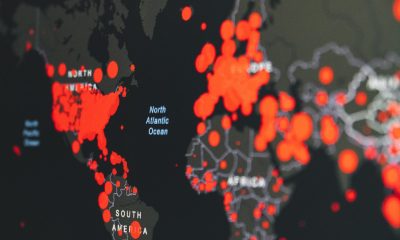Dinosaurs swam across thousands of miles of ocean to colonize Africa
The scientists labeled the phenomenal cross-continental journey a 'once-in-a-million year event'.
Published
2 months ago onBy
Talker News
By James Gamble via SWNS
A pony-sized dinosaur species swam or floated across thousands of miles of ocean to colonize Africa, according to a new study.
Fossils belonging to three species of duck-billed dinosaurs were found in Morocco - several hundred miles from where they evolved in North America.
An international team of scientists has suggested that, though nearly impossible, some of the huge dinos must have either floated or swam across to then-isolated Africa up to 66 million years ago.
The researchers also discovered that, once in Africa, the duckbilled dinosaurs not only survived but thrived and became diverse throughout their new continent.
The scientists labeled the phenomenal cross-continental journey a 'once-in-a-million year event'.
At the end of the Cretaceous period, some 66 million years ago, high sea levels and the breakup of the supercontinent Pangaea isolated Africa as a lone island continent, surrounded by water on all sides.
However, the remains of a member of the duckbill dinosaur family that evolved in North America were recently found in northern Africa - prompting questions as to how they got there.
The fossils, found in modern-day Morocco, revealed a new species of pony-sized duckbill dinosaur, called Minqaria bata, which measured between three and four meters long and weighed around 250kg.
Though the animal was tiny in comparison with many of its duckbill contemporaries - some of which measured up to 30ft long and weighed a whopping two tonnes - the bones of the discovered skull were tightly knit together, suggesting it was mature.

The anatomy of the new species closely resembles that of the European species, prompting researchers to reluctantly suggest the dinosaurs swam or floated across several hundred kilometers of open ocean to colonize North Africa.
The additional discoveries of even bigger bones suggest a third, larger species around five to six meters long also inhabited the continent.
The Minqaria bata - Arabic for ‘beak’ and ‘duck’, respectively - closely resembles the only previously known African duckbill, Ajnabia odysseus, though the shape of its jaws and teeth are distinct, proving it was a different species.
The researchers explained that both the Minqaria and Ajnabia were part of the subfamily Lambeosaurinae, a group of duckbills known for their elaborate head crests which housed long nasal passages that resonated like a horn.
Dr. Nicholas Longrich, from the University of Bath's Department of Life Sciences and the Milner Centre for Evolution, suggested they were likely social animals much like birds.
Dr. Longrich, who led the study published in the journal Scientific Reports, said: “These were probably loud, vocal animals.
“Modern birds vocalize to find mates or to declare territories.
"But they’re especially vocal in flocks - a flock of flamingos or a nesting colony of pelicans is extremely noisy, constantly communicating.
“So it’s likely that like birds, these duckbills were social animals.”

The Minqaria's brain is also large by dinosaur standards - a feature associated with social animals such as crows and primates like us.
"There were probably very loud, noisy herds - or flocks if you prefer - of these little duckbills wandering the coasts of Morocco 66 million years ago," Dr. Longrich added.
The bones surrounding the brain of the Minqaria were found to be 'tightly-knit' and 'partially fused', demonstrating the fact it was a fully-grown adult.
The other Moroccan species, Ajnabia, was about the same size, and larger bones studied by the team, including an arm and a thigh bone, suggest a third, larger species, which shows how the dinosaurs evolved in their new home.
"Not only did duckbills manage to reach Africa at the end of the Cretaceous,” Dr. Longrich continued, “But once they did, they quickly evolved to take advantage of open niches and became diverse.”
Sea levels were high at the end of the Cretaceous period, flooding much of the continents, and the Earth’s land was fragmented by the breakup of Pangaea and continental drift.
This left Africa floating alone in the ocean; an island continent much like modern-day Australia.
But duckbill dinosaurs, evolving long after the land connections had been broken, somehow mysteriously managed to get across to Africa.

Dr. Longrich and his team, made up of international scientists from universities in the UK, Morocco and Spain, said that though the dinosaurs traversing the oceans to get to Africa was unlikely, it appears to be exactly what happened.
"It’s extremely improbable that dinosaurs could cross water to get to Africa,” he said.
"But improbable isn’t the same as impossible. And given enough time, improbable things become probable.
"Buy a lottery ticket every day, and if you wait long enough, you’ll win.
“These ocean crossings might be once-in-a-million-year events but the Cretaceous lasted nearly 100 million years.
"A lot of strange things will happen in that time - including dinosaurs crossing seas.”
The researchers compared the anomaly of the crossing to the unusual journeys of some modern-day animals, such as a group of at least 15 iguanas swept off the shores of Guadeloupe in the Caribbean by a hurricane and washed up on the island of Anguilla - around 200 miles away - a month later in 2015, or a tortoise from the island of Aldabra that once drifted ashore in Tanzania, 700 kilometers away.
Deer, elephants and hippos are also all known to have swam out to the Greek island of Crete during the ice age.

“These duckbills are maybe the most surprising find of my career,” Dr. Longrich admitted.
“If you asked me what kind of dinosaurs we’d find in Africa, then a duckbill is the last thing I would have imagined, let alone three species.
“There’s still so much unknown in the fossil record, but if there wasn’t, we wouldn’t need to keep collecting fossils.”
Study co-author Dr. Nour-Eddine Jalil, of the Natural History Museum in Paris and the Université Cadi Ayyad in Morocco, added: “The phosphates of Morocco offers new images on past biodiversity in a key period of the history of life, the last moments of the dinosaur age followed by the diversification of mammals, announcing a new era.
“Minqaria and its relatives are players that a few years ago we would never have supposed to be on the African continent at that time.
“Despite their marine origin, these phosphates of Morocco also contain remains of vertebrates that lived on land.
"They constitute one of the only windows on the terrestrial ecosystems in Africa.
"The dinosaur remains suggest a great diversity, all the three major groups of dinosaurs are represented, the abelisaurid carnivores and the sauropod and ornithischian herbivores.”
Stories and infographics by ‘Talker Research’ are available to download & ready to use. Stories and videos by ‘Talker News’ are managed by SWNS. To license content for editorial or commercial use and to see the full scope of SWNS content, please email [email protected] or submit an inquiry via our contact form.
You may like


Cancer survivors from poorer places at higher risk of second cancer


Scientists estimate as much as 11M tons of plastic sitting on ocean floor


Scientists say this disease most likely to cause next global pandemic


Study finds longest recorded COVID infection lasted nearly two years


Scientists create family tree of coffee for clues to resist climate change


Tiny ingestible beads could help fight liver disease: study
Other Stories


Blood test can detect signs of knee condition 8 years before X-rays
Early detection could lead to treatments that slow the progression of the most common form of arthritis.


Man captures ultra rare albino squirrel on camera
The white squirrel has red eyes so is thought to be an albino squirrel.


Adorable dog kicks his leg while he walks
A video captured the pup bouncing along the street of his native China.


Woman with rare ‘Sleeping Beauty’ condition sleeps every four hours
She was diagnosed at age 18 after years of struggling to stay awake in school and nodding off during class.


97-year-old veteran receives WWII service medal 80 years later
"We’re all so proud of Eve."
Top Talkers

 Parenting1 week ago
Parenting1 week agoSingle mom details struggles of feeding her 12 kids

 Lifestyle1 week ago
Lifestyle1 week agoWoman regrets her tattoo nightmare: ‘It’s horrendous’

 Health5 days ago
Health5 days agoNew study reveals ‘old age’ begins later than it used to

 Wildlife4 days ago
Wildlife4 days agoClever elephant returns visitor’s shoe that fell into enclosure

 Good News5 days ago
Good News5 days agoDisabled student takes first steps in 10 years on graduation stage

 Animals17 hours ago
Animals17 hours agoAdorable dog kicks his leg while he walks

 Entertainment2 days ago
Entertainment2 days agoWhat is the perfect movie length?

 Broadcast22 hours ago
Broadcast22 hours agoAre allergies interfering with your social life?
